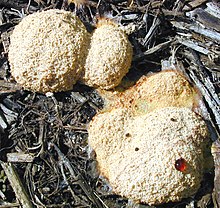Mycetozoa
| Mycetozoa | |
|---|---|

| |
| Aethalium of a slime mold (Fuligo septica) | |
| Scientific classification | |
| Domain: | Eukaryota |
| Phylum: | Amoebozoa |
| Subphylum: | Conosa |
| Infraphylum: | Mycetozoa de Bary, 1873 |
| Classes and orders | |
| |
| Synonyms | |
| |
Mycetozoa is a polyphyletic grouping of slime molds.[2] It was originally thought to be a monophyletic clade, but recently it was discovered that protostelia are a polyphyletic group within Conosa.[3]
Classification
It can be divided into dictyostelid, myxogastrid, and protostelid groups.[4]
The mycetozoan groups all fit into the
Utility in research
The
Physarum polycephalum are useful for studying cytoplasmic streaming. They have also been used to study the biochemical events that surround mitosis, since all of the nuclei in a medium-sized plasmodium divide in synchrony. It has been observed that they can find their way through mazes by spreading out and choosing the shortest path, an interesting example of information processing without a nervous system. Myxomycete plasmodia have also been used to study the genetics of asexual cell fusion. The giant size of the plasmodial cells allows for easy evaluation of complete or partial cell fusion.
In 2006, researchers at the University of Southampton and the University of Kobe reported that they had built a six-legged robot whose movement was remotely controlled by a Physarum slime mold.[5] The mold directed the robot into a dark corner most similar to its natural habitat.
Slime molds are sometimes studied in advanced mathematics courses. Slime mold aggregation is a natural process that can be approximated with
Meiosis
Members of the Mycetozoa group are able to undergo sexual reproduction either by heterothallic or homothallic mating.[6][7][8] An analysis of meiosis-related genes in the Dictyostelium discoideum genome revealed that 36 of the 44 genes tested were present in the genome.[9] One gene, Spo11, was absent in the Mycetozoa, raising questions about the assumed universal role of Spo11 as an initiator of meiosis.[9]
-
Slime mold on lawn, USA. Trail of movement can be seen.
-
Scotland.
-
Sporangia types in theStemonitales, Physarales)
References
- PMID 5762760.
- ^ "Mycetozoa - Definition from Merriam-Webster's Medical Dictionary". Retrieved 2009-03-27.
- PMID 19656720.
- PMID 9342353.
- ^ "Robot moved by a slime mould's fears - tech - 13 February 2006 - New Scientist". Retrieved 2009-03-27.
- S2CID 23172357.
- PMID 20617172.
- S2CID 205599638.
- ^ PMID 28087686.
External links
- Slime Molds
- Slime Mold Solves Maze Puzzle from abc.net.au
- Hunting Slime Molds from Smithsonian Magazine
- "Robot Piloted by a Slime Mold". Slashdot. 2006. Retrieved February 15, 2006.
- dictyBase is an online informatics resource for Dictyostelium, a cellular slime mould.
- nomen.eumycetozoa.com is an online nomenclatural information system of slime moulds (Myxomycetes, Dictyostelids and Protostelids) of the world.
- Photo gallery Archived 2016-10-13 at the Wayback Machine
- Introduction to the "Slime Molds"
- Slime Mold Photos Life cycle of Reticularia lycoperdon at MushooMania.com.
- Video footage of common slime moulds.




